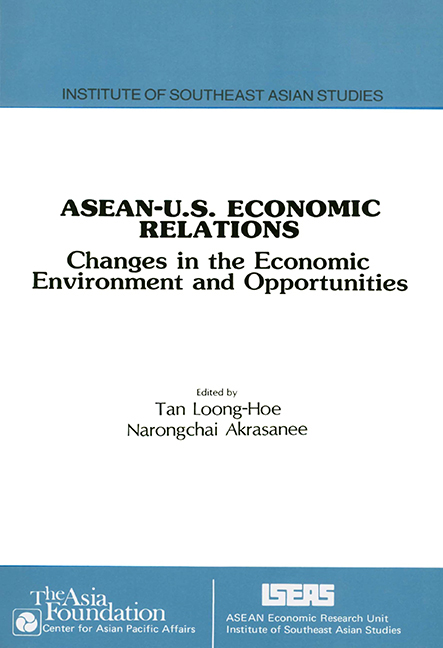Book contents
- Frontmatter
- Contents
- List of Tables
- List of Figures
- Foreword
- Changes in the ASEAN-U.S. Economic Environment and Opportunities: An Introductory Overview
- PART I ECONOMIC TRENDS
- PART II STRUCTURAL ADJUSTMENTS
- 3 Structural Adjustment in ASEAN
- 4 What Kind of Structural Adjustment Policies for U.S. Trade Difficulties?
- PART III TRADE IN SERVICES
- PART IV ROLE OF PRIVATE SECTOR
- THE EDITORS
4 - What Kind of Structural Adjustment Policies for U.S. Trade Difficulties?
from PART II - STRUCTURAL ADJUSTMENTS
Published online by Cambridge University Press: 21 October 2015
- Frontmatter
- Contents
- List of Tables
- List of Figures
- Foreword
- Changes in the ASEAN-U.S. Economic Environment and Opportunities: An Introductory Overview
- PART I ECONOMIC TRENDS
- PART II STRUCTURAL ADJUSTMENTS
- 3 Structural Adjustment in ASEAN
- 4 What Kind of Structural Adjustment Policies for U.S. Trade Difficulties?
- PART III TRADE IN SERVICES
- PART IV ROLE OF PRIVATE SECTOR
- THE EDITORS
Summary
The Setting of the Problem
The present anxieties over trade issues on Capitol Hill cannot be more clearly seen than by the alacrity with which the protectionist bill, HR 4800, was pushed through the House of Representatives in May 1986 by more (han a two-third majority vote. In August of the same year, the House missed overriding President Reagan's veto of a stringent quota bill on textiles by only eight votes. It is no exaggeration on my part to describe the situation on Capitol Hill as:
A spectre is haunting the United States, the spectre of deindustrialization. All the powers of the old manufacturing interests have entered into a holy alliance to exorcise this spectre; National Association of Manufacturers and AFLCIO, Senator Helms and Representative Gephardt, martini-bearing lobbyists and academic scribblers.
The belligerence with which HR 4800 obligates the President to use tariffs and quotas to end any “excessive [bilateral] trade surplus” arising from loosely defined “unfair trading practices” threatens to unleash a global trade war. It was therefore only appropriate that President Reagan called HR 4800 a “kamikaze” measure and warned that it could, after the fashion of the Smoot-Hawley tariffs of 1930, “send [the U.S.] economy into the steepest nose dive since the Great Depression”. The dominance of protectionist sentiments in public discussion is best understood by the fact that the size of the current account deficits of the last two years is without precedent in post-war American economic performance. Until 1983, the current account deficit had never exceeded $50 billion (in constant 1982 dollars) but in 1984 it was a gaping $84 billion (see Table 4.1). The current account deficit deteriorated further in 1985 to $108 billion. These current account deficits were large in relative terms as well. The current account deficits in 1984 and 1985 were 2 and 3 per cent of GNP respectively. All previous current account deficits were less than 1 per cent of GNP.
The seriousness of the deterioration in American trade performance is well illustrated by the balance in the trade of manufactured goods.
- Type
- Chapter
- Information
- ASEAN-U.S. Economic RelationsChanges in the Economic Environment and Opportunities, pp. 89 - 112Publisher: ISEAS–Yusof Ishak InstitutePrint publication year: 1988



